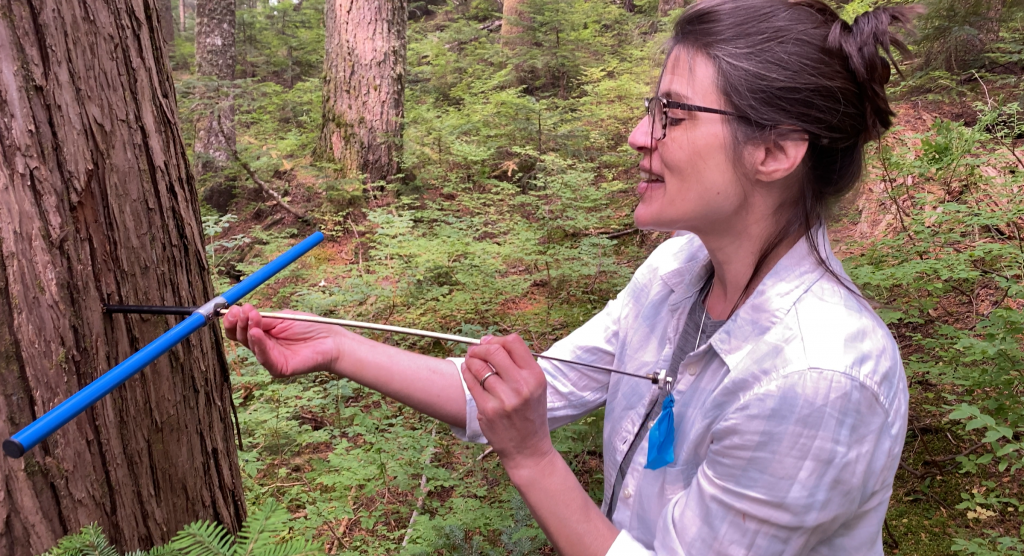
View Dr. Hewitt’s digital tour of the Dakota Bear Sanctuary
How to unlock the mysteries of a biological database
An increment borer – basically a corkscrew for trees – is the tool of choice to age living trees without having to cut them down.
Coring a tree removes a tiny strip of the tree’s cross section to reveal annual growth rings hidden inside the trunk.
“It’s about the equivalent for the tree of losing a small branch,” says Dr. Nina Hewitt of UBC Vancouver Department of Geography.
“The tree will immediately put some sap in there,” she says, healing over the point of entry.
SUPPORT MY WORK ON PATREON FOR EXCLUSIVE ART & TRAIL CAM CONTENT
Watch below as Dr. Nina Hewitt explains the principles of dendrochronology, the science of dating trees according to annual rings, in an ancient yellow cedar forest, known as the Dakota Bear Sanctuary in Sḵwx̱wú7mesh (Squamish) territory on Mount Elphinstone (Sunshine Coast, BC, Canada).
View Dr. Hewitt’s digital tour of the Dakota Bear Sanctuary
Ancient tree core data has vast applications in science, history and law
A tree’s cross section reveals more than just the tree’s age. It provides information about past climate conditions, including droughts and unseasonable rains, pest epidemics, and even the historical health of salmon runs.
Data stretches back as far as the tree has lived. For the most ancient trees, this biological database can cover a thousands years or more.
If a trees was harvested in the past by indigenous people – for bark strips, pitch pots, or wooden slabs – that tree would continue to live on and heal, and record that harvest in its heartwood database.
A cross section can confirm the date of that harvest, and provide important proof of occupation that has been used to help assert indigenous rights and title over traditional territories.
Cross dating neighbouring trees can improve accuracy and reveal missing or double rings, which can happen in years of extreme seasons or drought.
How to core a tree: Step-by-step instructions from Dr. Nina Hewitt
1) Choose your tree and assemble your tree corer/increment borer. (Shown in the figure is a Haglof increment borer.)
2) Apply bees wax at the tip and along the length of the bit of your tree corer to lubricate it. (The last thing you want, is to get it stuck in the tree!)
3) Choose a good spot close to the base that is easy to access. This can be at chest height, the same height you would measure a tree’s diameter, for easy extraction; or, if capturing the earliest ring, lower down, nearer to ground level.
4) Remove a small bit of the bark if necessary to get a good entry point.
5) Aim for the centre of the tree to improve your chances of a full set of rings. Apply pressure until the corer bites the wood.
6) Holding the ends of the handle firmly, turn in a clockwise direction until you reach the centre. You may wish to use your extractor spoon to gauge your progress towards the centre of the tree.
7) When you think you’ve reached the centre, insert the spoon all the way.
8) Turn the corer back one half-turn in a counter-clockwise direction (see video).
9) Carefully withdraw the spoon to remove the core sample. Place the sample in a specialized straw for safe transport.
9) Remove the coring instrument from the tree as soon as possible, as the tree will tend to exert more pressure over time.
10) Once back in the lab, allow the core to air dry, then mount and sand the sample for inspection. To examine tree rings, dendrochronologists employ measuring stages and microscopes, or more recently, digital imagery and software to identify rings and measure their width. The result is a ring-series that shows the patterns of growth over the tree’s life.
OPTIONAL EXTRA STEPS:
11) Cross-date the tree with some of its neighbours to reveal missing or false rings, which can be caused by atypical climate conditions, like droughts, unseasonably hot/cold temperatures or extreme rainfall. Most tree-ring research involves cross-dating of individual tree cores with regional chronologies.
12) Perform radioisotopic analyses of tree rings to indicate chemical composition and assist in dating.
SUPPORT MY WORK ON PATREON – THANK YOU!
ADDITIONAL RESOURCES:
Dr. Nina Hewitt’s Coastal Forest Virtual Field Trip
“This lab explores a large remnant of Coastal forest in Pacific Spirit Park, Point Grey, Vancouver, to examine its species composition, structure and dynamics, particularly in relation to human and natural disturbance processes. A set of 360° photos and videos (one in 360°) will be used to demonstrate the local species and landscapes. At the end of the lab, students should have an appreciation for the main species present and the sorts of processes that affect coastal forest dynamics, both natural and human-caused.”
